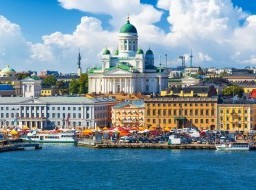Finlandia Hall
The Finlandia Hall is a congress and event venue in the centre of Helsinki on the Töölönlahti Bay. The building, which was designed by architect Alvar Aalto, was completed in 1971. Every detail in the building is designed by Aalto. The designs were completed in 1962, with building taking place between 1967–1971. The Congress Wing was designed in 1970 and built in 1973–1975. In 2011, the building was expanded with new exhibition and meeting facilities. The inauguration of the Finlandia Hall was celebrated on 2 December 1971. The inauguration concert included the first performance of Einojuhani Rautavaara’s Meren tytär (‘Daughter of the Sea’) and Aulis Sallinen’s Symphony (opus 24), as well as Sibelius’s violin concerto with Isaac Stern as the violin soloist of the Helsinki Philharmonic Orchestra. A comprehensive history of the Finlandia Hall, Events, People and Music, was published in 2001 by the Otava Publishing Company. The book was written by Pekka Suhonen, Petri Mustonen and Eeva-Kaarina Holopainen. The versatile and flexible meeting, exhibition, festival and concert facilities of the Finlandia Hall offer a setting for both large international congresses and small-scale meetings, and for various entertainment and public events. The Finlandia Hall has proved its ability to serve as a venue for several world congresses and as a forum for the world’s top economic and political leaders. The building itself is a popular attraction visited by thousands of tourists from all over the world every year. The building is owned by the City of Helsinki. Architecture The main feature of the Finlandia Hall building is a tower like section with a sloping roof. Alvar Aalto’s idea behind the design was that a high empty space would provide better acoustics. A lattice ceiling hides the space to the audience but it allows the creation of the same deep post-echo as tall church towers. Aalto used marble in both indoor and outdoor surfaces as a contrast to black granite. For Aalto, marble was a tie to the Mediterranean culture, which he wanted to bring to Finland. Finlandia Hall features an optical illusion: the National Museum building on the other side of the street seems to rise from the edge of the Finlandia Hall tower. The effect is created by a black trapezium on the white marble surface of the Finlandia Hall tower. The trapezium has been measured to fit the rising tower of the National Museum when the Finlandia Hall is viewed from the eastern shore of the Töölönlahti Bay. Aalto liked to create optical illusions. Another example of this can be found on the pedestrian path behind the library building of the Helsinki University of Technology (current Aalto University) in Espoo. The interior design of the building is a tribute to detail. The design of each lamp, piece of furniture, panel, flooring material and decorative board reflects the mature approach resulting from Aalto’s long career as an architect. All the materials speak the language of nature, simply without technically artificial tones. This is because Aalto’s basic view was that architecture should create a frame for human beings. In the Finlandia Hall, the focus is not on extraordinary forms or ostentatious interior. It is on the audience and on the performers. According to Aalto, the audience at the Finlandia Hall need not dress up like people used to in the opera foyers and gilded concert halls of the old days. What people wear should be as genuine and natural as the environment in the building. |




